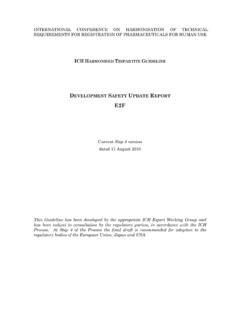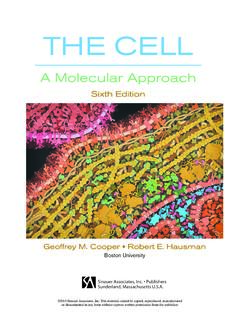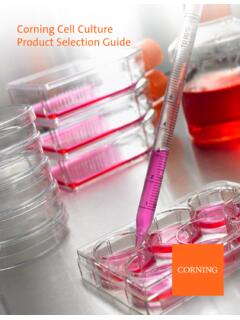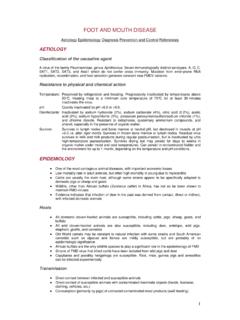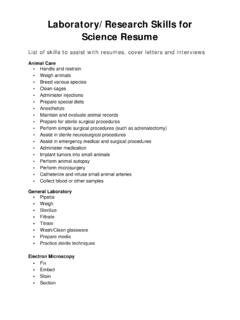Transcription of ICH HARMONISED TRIPARTITE GUIDELINE
1 INTERNATIONAL CONFERENCE ON HARMONISATION OF TECHNICAL REQUIREMENTS FOR REGISTRATION OF PHARMACEUTICALS FOR HUMAN USE ICH HARMONISED TRIPARTITE GUIDELINE DERIVATION AND CHARACTERISATION OF CELL SUBSTRATES USED FOR PRODUCTION OF BIOTECHNOLOGICAL/BIOLOGICAL PRODUCTS Q5D Current Step 4 version dated 16 July 1997 This GUIDELINE has been developed by the appropriate ICH Expert Working Group and has been subject to consultation by the regulatory parties, in accordance with the ICH Process. At Step 4 of the Process the final draft is recommended for adoption to the regulatory bodies of the European Union, Japan and USA. Q5D Document History First Codification History Date New Codification November 2005 Q5D Approval by the Steering Committee under Step 2 and release for public consultation. 10 January 1997 Q5D Current Step 4 version Q5D Approval by the Steering Committee under Step 4 and recommendation for adoption to the three ICH regulatory bodies.
2 16 July 1997 Q5D i DERIVATION AND CHARACTERISATION OF CELL SUBSTRATES USED FOR PRODUCTION OF BIOTECHNOLOGICAL/BIOLOGICAL PRODUCTS ICH HARMONISED TRIPARTITE GUIDELINE Having reached Step 4 of the ICH Process at the ICH Steering Committee meeting on 16 July 1997, this GUIDELINE is recommended for adoption to the three regulatory parties to ICH TABLE OF CONTENTS 1. INTRODUCTION .. 1 Objective .. 1 Rationale .. 1 Scope .. 1 2. GUIDELINES .. 2 Source, History, and Generation of the Cell Substrate .. 2 Introduction .. 2 Origin, Source, and History of cells .. 2 Generation of the Cell Substrate .. 3 Cell Banking .. 3 Cell Banking System .. 4 Cell Banking Procedures .. 4 General Principles of Characterisation and Testing of Cell Banks .. 5 Tests of Identity .. 6 Metazoan cells .. 6 Microbial cells .. 7 Tests of Purity .. 7 Metazoan cells .. 7 Microbial cells .. 8 Cell Substrate Stability .. 8 Tests for Karyology and Tumorigenicity.
3 9 3. GLOSSARY .. 10 APPENDIX 1: PRIMARY CELL SUBSTRATES .. 12 1 DERIVATION AND CHARACTERISATION OF CELL SUBSTRATES USED FOR PRODUCTION OF BIOTECHNOLOGICAL/BIOLOGICAL PRODUCTS 1. INTRODUCTION Objective The objective of this GUIDELINE is to provide broad guidance on appropriate standards for the derivation of human and animal cell lines and microbial cells to be used to prepare biotechnological/biological products defined in Section , Scope, and for the preparation and characterisation of cell banks to be used for production. The document, therefore, provides recommendations on the information in these areas that should be presented in market applications for these products. Rationale Historically, some quality concerns for cell-derived biological products have originated from the presence of adventitious contaminants or from the properties of the cells used to prepare the product.
4 Recombinant DNA (rDNA) - derived products also carry quality concerns regarding the expression construct contained in the cell substrate. Thus, it is well established that the properties of the cell substrate and events linked to the cell substrate can affect resultant product quality and safety and, further, that effective quality control of these products requires appropriate controls on all aspects of handling the cell substrate. This document complements other guidelines to provide a comprehensive approach to quality issues arising from biological aspects of processing products from metazoan and microbial cell culture . Scope This GUIDELINE covers cell substrates having a cell banking system. In this document, cell substrate refers to microbial cells or cell lines derived from human or animal sources that possess the full potential for generation of the desired biotechnological/biological products for human in vivo or ex vivo use.
5 Reagents for in vitro diagnostic use are outside the scope of this document. animal sources of cell lines include all those of metazoan origin. Both continuous cell lines of indefinite in vitro lifespan and diploid cells of finite in vitro lifespan are included. Microbial sources include bacteria, fungi, yeast, and other unicellular life forms. Biotechnological/biological products refers to any products prepared from cells cultivated from cell banks with the exception of microbial metabolites such as, for example, antibiotics, amino acids, carbohydrates, and other low molecular weight substances. Cell banks used to prepare gene therapy products or vaccines should follow the recommendations presented in this document. Some biological products, such as certain viral vaccines, are prepared in primary cell cultures derived directly from animal tissues or organs.
6 Primary cells are not banked and therefore are not addressed by this document. However, other considerations which may apply to primary cells are discussed further in Appendix 1 of this document. Derivation and Characterisation of Cell Substrates 2 2. GUIDELINES Source, History, and Generation of the Cell Substrate Introduction It is important to provide supportive documentation which describes the history of the cell substrate that is used in the manufacture of a biotechnological/biological product, as well as any parental cell line from which it was totally or partially derived. Events during the research and development phases of the cell substrate may contribute significantly to assessment of the risks associated with the use of that particular cell substrate for production. The information supplied in this regard is meant to facilitate an overall evaluation which will ensure the quality and safety of the product.
7 Careful records of the manipulation of the cell substrate should be maintained throughout its development. Description of cell history is only one tool of many used for cell substrate characterisation. In general, deficiencies in documented history may not, by itself, be an impediment to product approval, but extensive deficiencies will result in increased reliance on other methods to characterise the cell substrate. Origin, Source, and History of cells The source of cells (laboratory or culture collection) from which the cell substrate was derived should be stated, and relevant references from the scientific literature should be cited. Information obtained directly from the source laboratory is preferred. When this is not available, literature references may be utilised. For human cell lines, it is relevant to describe the following characteristics of the original donor: Tissue or organ of origin, ethnic and geographical origin, age, sex and general physiological condition.
8 If known, the state of health or medical history of the donor should be reported along with the results of any tests of the donor for pathogenic agents. Specifically for human diploid fibroblasts, the age of the donor may influence the in vitro lifespan of the cell line and this information should be provided if available. For animal cell lines, relevant descriptions of the source include species, strains, breeding conditions, tissue or organ of origin, geographical origin, age and sex, the results of tests for pathogenic agents, and general physiological condition of the original donor. For microbes, manufacturers should describe the species, strain, and known genotypic and phenotypic characteristics of the organism from which the cell substrate was derived. Manufacturers should also describe the pathogenicity, toxin production, and other biohazard information, if any.
9 The cultivation history of the cells should be documented. The method originally used for the isolation of the cells should be described as well as the procedures used in the culturing of the cells in vitro and any procedures used to establish cell lines (for example, use of any physical, chemical, or biological procedure, or added nucleotide sequences ). A description of any genetic manipulation or selection should be provided. All available information regarding the identification, characteristics, and results of testing of these cells for endogenous and adventitious agents should be provided. For continuous cell lines of metazoan origin, it is usually adequate to quantitate culture duration by estimation of either number of population doublings, or number of subcultivations at defined dilution ratio, or time in days. For diploid cell lines Derivation and Characterisation of Cell Substrates 3 possessing finite in vitro lifespan, accurate estimation of the number of population doublings during all stages of research, development, and manufacturing is important.
10 For microbial cells , documentation of subcultivation frequency after cell substrate generation is considered adequate. Regarding the generation of cell substrates, applicants should provide a thorough discussion of procedures which would provide exposure to infectious agents. Constituents of the culture medium should be described, in particular, information regarding exposure of the cells to materials of human or animal origin such as serum, enzymes, hydrolysates, or other living cells . The description should include the source, method of preparation and control, test results, and quality assurance. Relevant literature on these points may be referenced when available. This information will allow a detailed analysis of potential entry routes for adventitious agents from these sources, and will be part of the risk-benefit analysis of the product.
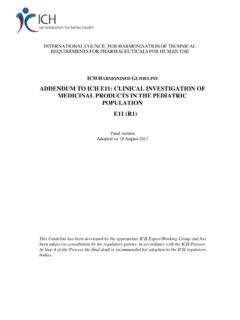
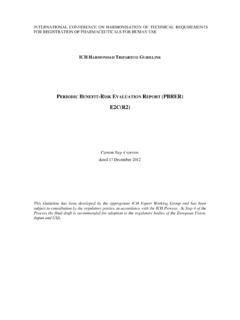
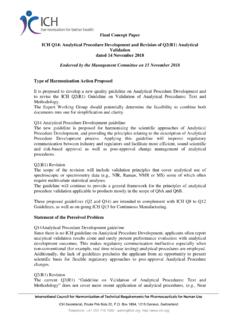
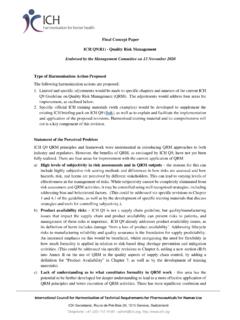
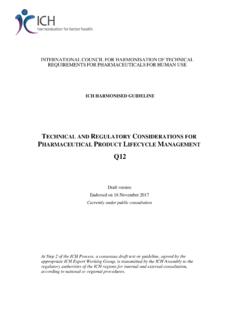
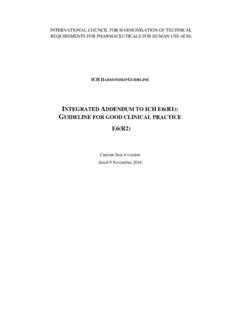
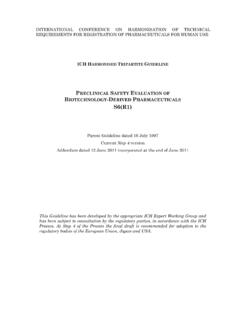
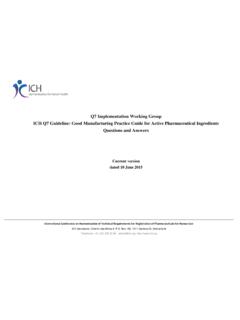
![[ICH E2F] [EXAMPLE DSUR – PHASE III INVESTIGATIONAL …](/cache/preview/e/7/a/2/e/6/3/0/thumb-e7a2e63043c4463724e748eb98faa3a7.jpg)
